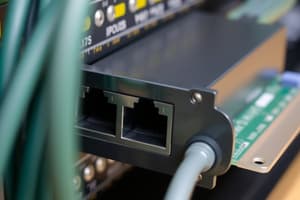Podcast
Questions and Answers
Explain how a router facilitates communication between different networks.
Explain how a router facilitates communication between different networks.
A router joins two or more networks and passes information from one network to another; ensuring the message gets to the destination efficiently.
What is the role of protocols in network communication?
What is the role of protocols in network communication?
Protocols are the rules and standards on how messages are sent, directed, and interpreted across a network.
Why is it necessary to convert all types of messages (text, video, voice) into bits before sending them over a network?
Why is it necessary to convert all types of messages (text, video, voice) into bits before sending them over a network?
To standardize the format of data for transmission across the network. This allows all devices to process the information consistently.
How does a Network Interface Card (NIC) enable a computer to connect to a network?
How does a Network Interface Card (NIC) enable a computer to connect to a network?
Describe the primary function of a firewall in network security.
Describe the primary function of a firewall in network security.
What does the term 'fault tolerance' mean in the context of network architecture?
What does the term 'fault tolerance' mean in the context of network architecture?
In the context of networks, what is 'scalability,' and why is it important?
In the context of networks, what is 'scalability,' and why is it important?
What are network services? Give an example.
What are network services? Give an example.
What are the four elements of a network?
What are the four elements of a network?
What is the most common wired internetworking technology?
What is the most common wired internetworking technology?
Flashcards
Network Elements
Network Elements
Devices, media, services, tied together by rules, that work together to send data.
Protocols
Protocols
These are the rules networked devices use to communicate with each other.
Router
Router
A device that joins two or more networks and passes information between them.
TCP/IP
TCP/IP
Signup and view all the flashcards
Network Interface Card (NIC)
Network Interface Card (NIC)
Signup and view all the flashcards
Physical Port
Physical Port
Signup and view all the flashcards
Interface
Interface
Signup and view all the flashcards
Fault Tolerance
Fault Tolerance
Signup and view all the flashcards
Scalability
Scalability
Signup and view all the flashcards
Quality of Service (QoS)
Quality of Service (QoS)
Signup and view all the flashcards
Signup and view all the flashcards
Study Notes
Internetworking Elements
- A typical network consists of devices, media, and services that are interconnected through rules to facilitate message exchange
- The term "messages" includes web pages, emails, instant messages, telephone calls, and other forms of communication online
Network Elements
- There are four crucial parts to a network: rules, medium, messages and devices
Internetworking
- Internetworking is graphically represented and uses icons for networking devices
Common Internetworking Symbols
- Switch: The most common device for interconnecting local area networks
- Firewall: Secures networks
- Router: Directs messages across a network
- Wireless Router: A specific type of router found in home networks
- Cloud: Summarizes a group of networking devices
- Serial Link: A type of WAN interconnection, depicted as a lightning bolt
Hardware
- Network Interface Card (NIC): Also known as a LAN adapter is the hardware providing a network connection to a PC or other host device.
- Physical Port: This is a connector or outlet on internetworking devices where a device connects to a host for networking services
- Interface: It is typically a specialized port on an internetworking device that connects to individual networks, routers use network interfaces for interconnection.
Network Services
- To support computer applications, humans require services like WWW, email, instant messaging and IP Telephony, these services need to be provided by the network
- Rules or protocols must govern devices interconnected by a medium providing services. These protocols enable networked devices to communicate while TCP/IP is the industry standard
- TCP/IP specifies formatting, addressing, and routing, ensuring messages reach the intended recipient
Transmitting Messages
- Before an instant message is transmitted, it is converted to a transmittable format
- All types of messages are converted to binary coded digital signals before being sent for delivery
Devices
- A wide range of devices, including computers, telephones, cameras, music systems, printers, and game consoles, can participate in network services
- Routers are essential components in networks of any size, connecting two or more networks and ensuring efficient message delivery
Mediums
- Computers need to connect to a wired or wireless local network to send a message to it's destination
- Wireless networking is available in public hotspots
- Ethernet is the primary wired technology, using cables to connect devices, best for high-speed, large-data transfers like multimedia
Services
- Network services like instant messaging must be accessible to both sender and recipient
- Programs supporting the human network include email, bulletin boards, chat rooms, and instant messaging
Messaging Rules
- Rules or protocols specify how messages are directed through the network and interpreted at the destination
- Protocols such as XMPP, TCP, and IP are critical for enabling communication with Jabber instant messaging
Network Architecture Basics
- Refers to the supporting technologies, programmed services, and protocols that move messages across an infrastructure
- Four key aspects of network architecture include fault tolerance, scalability, Quality of Service (QoS), and security
Fault Tolerance
- Fault-tolerant networks minimize hardware or software failure impact and allow quick recovery using redundant links or paths between source and destination
Scalability
- Scalable networks can quickly expand to accommodate new users and applications without impacting service performance
Quality of Service
- Converged internetworking is changing network architectures to accomodate the quality of service expectations
Security
- Network security requirements have evolved as the Internet has become a widely accessible means for business and personal communications
Studying That Suits You
Use AI to generate personalized quizzes and flashcards to suit your learning preferences.




